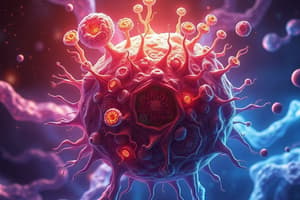Podcast
Questions and Answers
What is homeostasis?
What is homeostasis?
The ability of an organism to maintain a stable internal environment despite changes in external conditions.
Which of the following is a component of a feedback system?
Which of the following is a component of a feedback system?
- Receptor
- Stimulus
- Effector
- All of the above (correct)
What do receptors do in a feedback system?
What do receptors do in a feedback system?
They monitor changes in a controlled condition and send input to a control center.
Positive feedback systems reverse changes in controlled conditions.
Positive feedback systems reverse changes in controlled conditions.
What is the process of supplying the body with oxygen and removing carbon dioxide called?
What is the process of supplying the body with oxygen and removing carbon dioxide called?
The ______ system in vertebrates has blood flowing from the heart to the gills for oxygenation.
The ______ system in vertebrates has blood flowing from the heart to the gills for oxygenation.
What type of circulatory system do arthropods have?
What type of circulatory system do arthropods have?
What are the three basic steps of respiration?
What are the three basic steps of respiration?
Flashcards are hidden until you start studying
Study Notes
Levels of Organization
- Cellular Level
- Tissue Level
- Organ Level
- Organ System Level
Body Plans
- Symmetry
- Segmentation
- Body Cavity
Homeostasis
- Ability of an organism to maintain a stable internal environment despite changes in external conditions
- Internal environment of the body refers to the extracellular fluid (interstitial fluid and plasma) that surrounds body cells
Control of Homeostasis:
- Feedback system (feedback loop) – a cycle of events in which the status of a body condition is monitored, evaluated, changed, re-monitored, and re-evaluated
- Controlled variable – monitored variable (controlled condition), such as body temperature, blood pressure, blood glucose level
- Stimulus – any disruption that changes a controlled condition.
Feedback System: Basic Components
- Receptor – a body structure that monitors changes in a controlled condition and sends input to a control center.
- Afferent Pathway – information flows toward the control center
- Control center – sets the narrow range or set point within which a controlled condition should be maintained, evaluates the input it receives from receptors, and generates commands when they are needed.
- Efferent Pathway – information flows away from the control center
- Effector – a body structure that receives output from the control center and produces a response or effect that changes the controlled condition.
Feedback System: Types of Response
- Negative feedback system – reverses a change in a control condition
- blood pressure (BP) (controlled condition) – force exerted by blood as it presses against the walls of blood vessels
- baroreceptors (receptor) – pressure- sensitive nerve cells located in the walls of certain blood vessels, detect the higher pressure
- send nerve impulses (input) to the brain
- brain (control center) – interprets the impulses and responds by sending nerve impulses (output) to the heart and blood vessels (the effectors)
- heart and blood vessels (effectors) – heart rate decreases and blood vessels dilate (widen)
- Positive feedback system – strengthen or reinforce a change
- stretching of the cervix (controlled condition) – force exerted by blood as it presses against the walls of blood vessels
- stretch-sensitive nerve cells in the cervix (receptor) – monitor the amount of stretching of the cervix
- send more nerve impulses (input) to the brain
- brain (control center) – causes the pituitary gland to release the hormone oxytocin (output) into the blood
- muscles in the wall of the uterus (effectors) – contract more forcefully
Respiration
- Process of supplying the body with oxygen, and removing carbon dioxide
- Three (3) basic steps:
- Pulmonary ventilation – Breathing process involving the exchange of air between the atmosphere and lungs (O2 in, CO2 out).
- External (pulmonary) respiration – Gas exchange between alveoli and blood, where blood gains O2 and loses CO2.
- Internal (tissue) respiration – Gas exchange between blood and tissue cells, where blood loses O2 and gains CO2 during ATP production (cellular respiration).
Circulation
- Responsible for transporting nutrients, gases, hormones, and waste products throughout the body.
- Invertebrates
- Open Circulatory System – arthropods (insects, spiders) and mollusks (snails), the heart pumps hemolymph (a mix of blood and interstitial fluid) into open cavities where it bathes the organs directly; no veins or capillaries
- Closed Circulatory System – annelids (earthworms), the blood is enclosed in vessels, flowing in a continuous circuit driven by a heart
- Vertebrates
- Fish – single-loop circulatory system where blood flows from the heart to the gills for oxygenation and then to the rest of the body; two-chambered heart
Studying That Suits You
Use AI to generate personalized quizzes and flashcards to suit your learning preferences.




